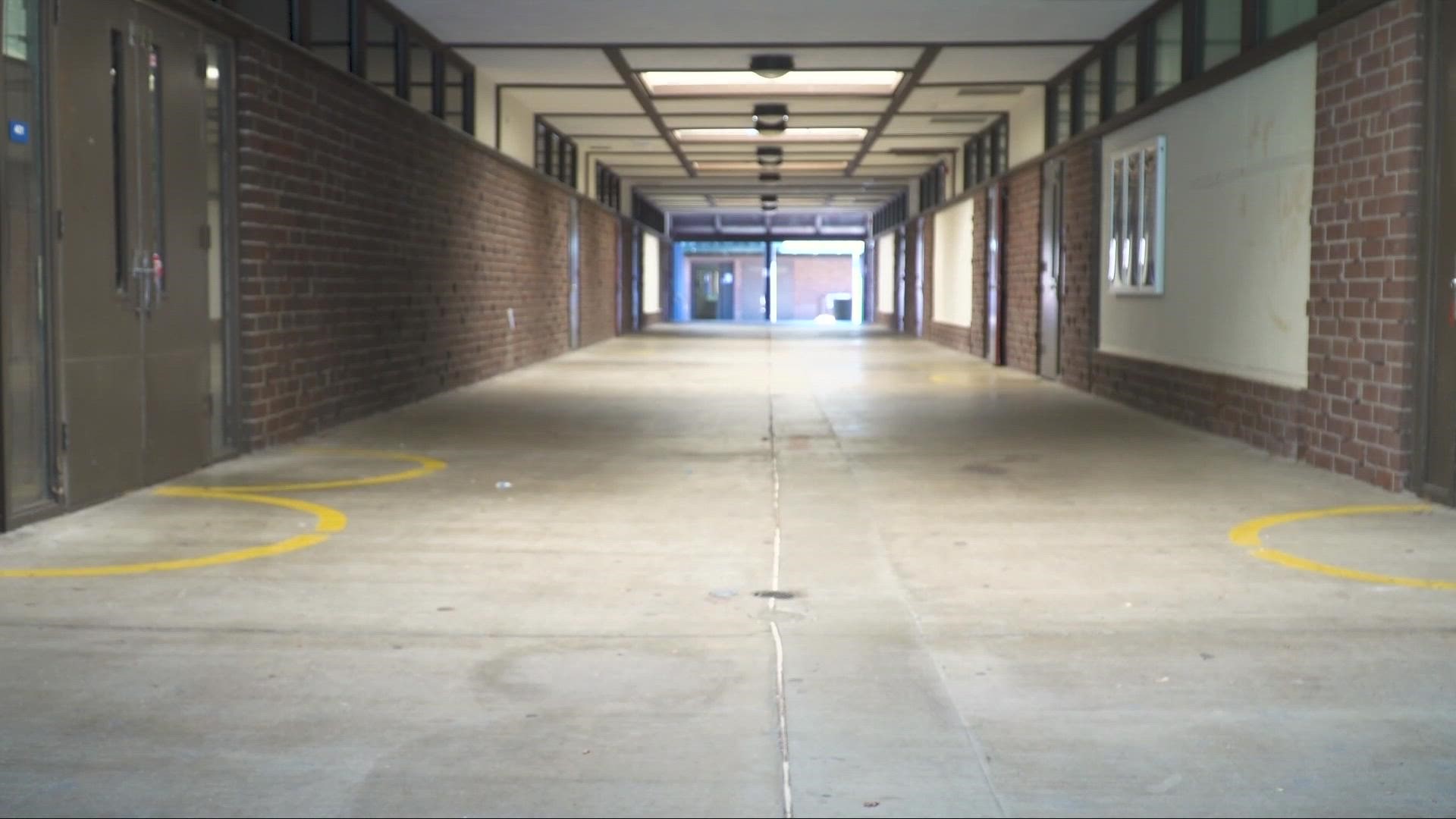SACRAMENTO, Calif — Over the past few weeks, ABC10 has taken a look at different aspects of the teaching industry in Northern California. From looking at the issue of the teacher shortage as a whole, to what is being done to recruit new teachers.
Now, ABC10 To The Point team is taking a look at two things: diversity in the classroom and the lack of teachers in very specific areas.
Across the country, there are more than 280,000 fewer teachers now than at the start of the pandemic, that's according to the National Education Association. Looking here in our state, the California School Boards Association believes the state needs roughly 100,000 teachers.
"63% of our teachers are white, (and) only 23% of our students are white," said Diana Lambert, the senior education reporter at EdSource — an independent non-profit organization that focuses on education in California. "(At the) same time, 50% of our students are Latino and 20% of our teachers are Latina, so there's definitely an imbalance there."
Lambert says the state is looking for ways to diversify the educator workforce.
"Tony Thurman has got together a task force, they're trying to find a way to recruit more specifically, black male teachers," she said. "But truthfully, I don't know any other ways. He said that's one of his main priorities for the year, but I think it's early on, they're just habitasse for so far."
Why does diversity in the classroom matter?
Research shows teachers of color have a positive impact on students.
The Learning Policy Institute, an independent research non-profit, found that when taught by teachers of color, students of color have higher test scores, are more likely to graduate high school, and more likely to succeed in college.
California School Boards Association’s Chief Information Officer Troy Flint explains.
"There's a lot of research that shows particularly at the earlier levels, that when students have a teacher that they identify with, that looks like them, that that can produce more engagement with school and better academic results," he said. "There's a real desire to get a wider variety of people into the teaching profession, particularly in some of these low-income schools that we talked about, where people were students have a certain experience, and not all teachers may be able to relate to that. Of course, you don't have to be from a certain environment, you don't have to be from the streets, you don't have to be from a rural area, to be effective in those in those settings. But certainly, it is helpful if you do have a background and some cultural knowledge. And that can translate to success in the classroom if you have the other skills in place."
What’s preventing more recruitment and retention of teachers of color?
Inadequate teacher preparation, poor working conditions, low salaries, and a lack of ongoing support for new teachers are part of the issue.
"Right now, about a third of the people who are entering the profession in California have what are called substandard credentials, doesn't mean that they won't be good teachers, but it just means they haven't completed all the certifications that would normally be required to enter the classroom," Flint said. "But because beggars can't be choosers, districts aren't in a position where they can be picky. Most districts aren't, can't hold out for those who have the full credential. They have to hire people who are still completing that work and that has equity issues because typically, it's the more affluent districts that can offer the higher salaries that kind of get their pick of the litter when it comes to getting those teachers. You tend to have more turnover at the low-income schools, which are generally but not always considered more demanding a little tougher environment. Because of that, you're getting those constant (turns) and that has really damaging effects on academic achievement for low-income kids, primarily black and brown kids who are in the school, also are rural students, where you don't have access to the same candidate pool. Those are the students are rural students are low-income students generally, and particularly African American and Latino students who are suffering because of the teacher shortage and the high rate of turnover in the profession. There's about an 8% attrition rate annually. If you multiply that over a span of years over, say, the 13 or 14 years that a kid is in a TK to 12 school environment, you see how many teachers are cycling through. That instability is a real impediment to academic achievement, especially for the kids who need the most support."
Are we seeing a difference between rural areas versus cities?
"The rural areas are definitely the hardest hit," Lambert said. "You know, for example, Konocti Unified up in Lake County has about 50% of his teachers working on an emergency credential who aren't fully prepared to teach the courses they're teaching. Last year, they started the short 12 teachers, even with those 50% of the teachers, underprepared. That's because when the rural areas are hard to your pool of teachers, people are qualified to be teachers is small. It's hard to recruit people to that place. What they have done, though, and that's really interesting thing, I think, is that they've turned to Montana. They go to Montana, and they go to teacher fairs in Montana, trying to attract teachers from that state here. The reason being this, Montana has that there aren't very many jobs for teachers in Montana, and they figured that like county similar, its role that has a lot of outdoor activities, so they try to attract those teachers, they are in a good portion of their teachers are from Montana."
It's important to note that California is able to attract teachers from other states partly based on pay.
The starting salary for a teacher in California, according to the National Education Association, is just over $49,000 (49,933). The top salary is nearly $100,000 ($99,912).
In Montana, those numbers start at $32,000 (32,495) and increase to nearly $66,000 (65,785).
A look at other teacher deficiencies: Bilingual teachers
"Half of all districts in California are reporting a shortage of bilingual teachers," said Flint. "This is really concerning given our demographics. We have more English learner students than any other state in the country, a huge percentage of English learner students of the nation as a whole. So if we are not adequately prepared to support these students who often need a greater degree of assistance, a greater degree of proficiency as they're learning a new language and trying to acquire knowledge across a variety of subjects in a language that's maybe not completely familiar to them. And then that is really going to impede the ability of our English learner students to succeed and is going to hurt the ability of the system overall, to produce well-qualified graduates, people who are capable of providing for their families, who can go out into various professions, who can engage civically and politically. I think that's something that's very important to recognize that lack of bilingual teachers is not just something that hurts English learners, students, it has an impact on communities widely. (In) California as a whole, this is a huge percentage of our student population, people that will be the adults, the decision makers of tomorrow, and these are potentially future leaders were losing potential that's being compromised because we are not able to provide them the support they need and deserve."
A look at other teacher deficiencies: Special education teachers
"(We are) being really diligent about trying to recruit people from all aspects of life, all parts of society, so that we are accessing the widest pool of candidates possible, and getting the most talented and committed teachers to serve our students," said Flint. "I think that's especially important for students in underserved areas, whether it's rural areas, whether it's our low-income students, whether it's students with disabilities or English learner students. It's a true equity issue, it's also an issue for our health as a society, for our ability to field engage adults who can participate in civic society, and in terms of our ability to remain prosperous, and hopefully, more equitable society in the future."
A look at other teacher deficiencies: Substitute teachers
"The substitute teacher shortage is the most dire shortage in schools right now," said Lambert. "Teachers, sometimes they have to merge classrooms fixes aren't enough teachers or substitute teachers, or put kids in gymnasiums, two and three classes in a gymnasium in some districts, not all, because they don't have enough substitute teachers. Substitutes sort of dropped off the map during COVID because there was no school for a year and a half, they had to find other jobs, right? Then they were paid that well, and they were afraid of COVID. It really reduced the ranks of substitute teachers and in response, some districts as much as doubled the substitute rate for a while due to temporary hikes. We'll see what next year brings, but this last year or year has been really hard on districts who can't find substitutes, especially have to add during COVID outbreaks, you know, you're covering teachers, substitutes don't want to come in, it's been really dramatic."



















